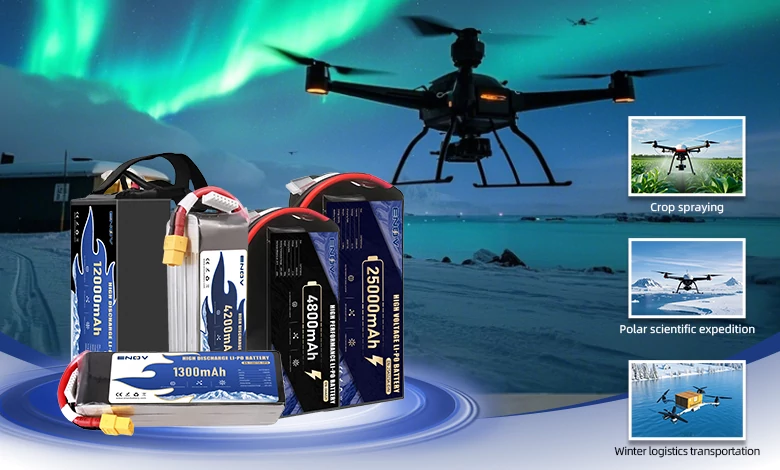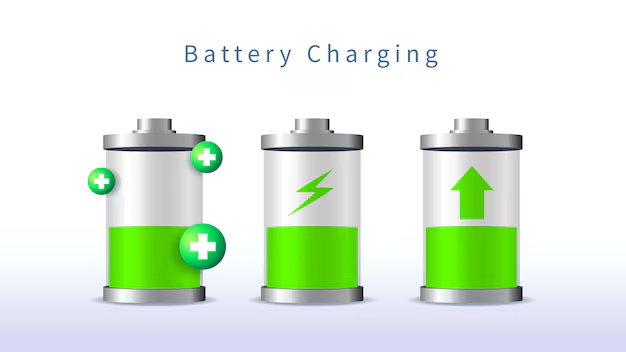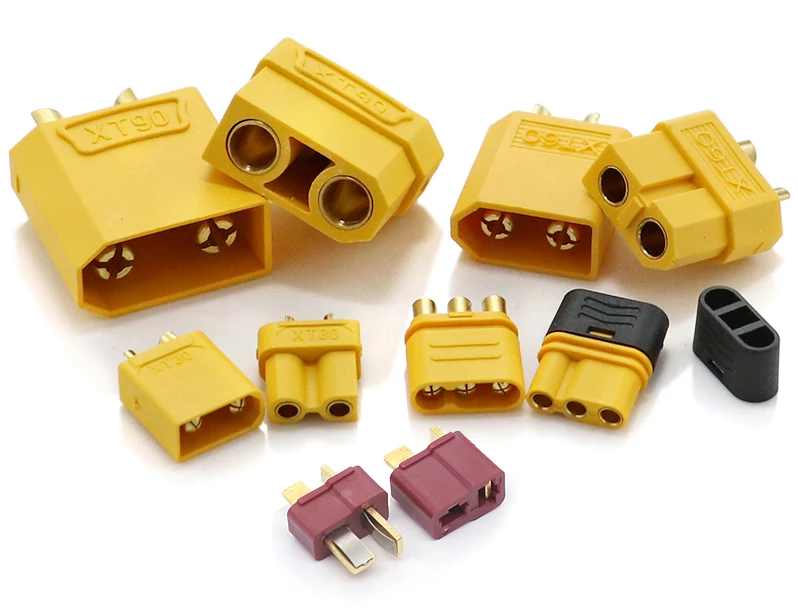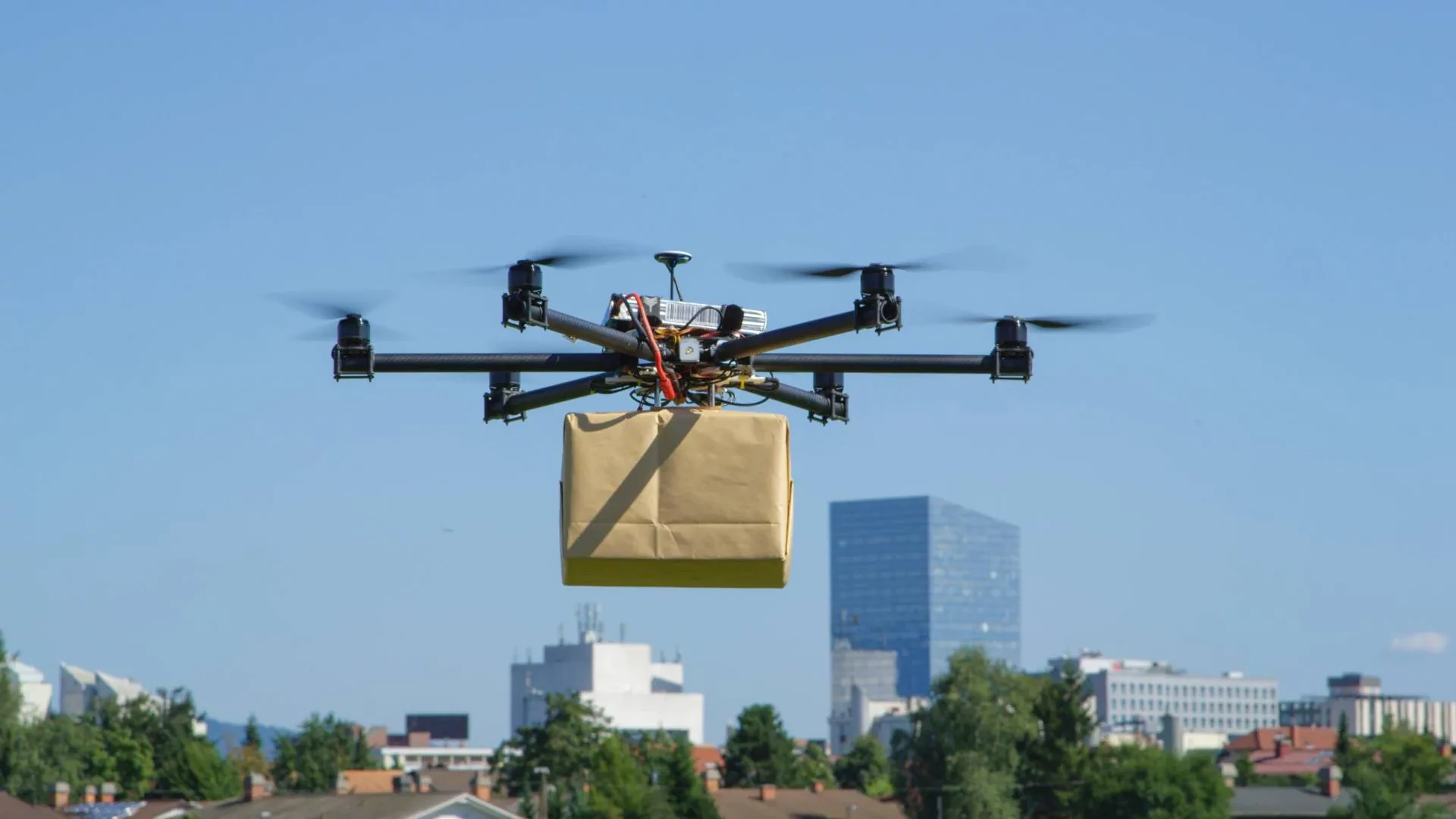Comprehensive Analysis of Multirotor UAVs

ENOV High-Energy drone batteries power industrial and commercial drones. Delivering 220–320 Wh/kg energy density, they enable long flight times (30+ mins) and support fast charging (2C). Perfect for aerial photography, surveillance, and delivery drones.
A multirotor UAV (Unmanned Aerial Vehicle) is an unmanned aircraft that relies on the coordinated rotation of three or more rotors to generate lift and thrust, enabling vertical takeoff and landing (VTOL), hovering, and agile flight. With its advantages of easy operation, high stability, and adaptability to complex scenarios, it has become the mainstream type in both consumer and industrial-grade UAVs, playing a crucial role in various fields such as aerial photography, logistics, agriculture, and rescue operations.
1. Core Features
The core advantages of multirotor UAVs stem from their unique “multi-rotor coordinated control” design, which is specifically reflected in the following aspects:
VTOL and Hovering Capability: It does not require a dedicated runway and can take off and land directly in narrow spaces such as indoors, on building rooftops, and in the wild. Some professional models can achieve high-precision hovering at the centimeter level, making them highly suitable for fixed-point operation scenarios like fixed-point photography and pesticide spraying.
Excellent Flight Agility: It can perform movements such as translation in any direction, in-place rotation, and low-speed flight. Even in complex environments like forests and between buildings, it can maneuver flexibly—an ability that fixed-wing UAVs (which require runways for takeoff and landing) and helicopters (with a single rotor plus tail rotor design) find difficult to achieve.
Relatively Simple Structure: Unlike fixed-wing UAVs that have complex wing structures and helicopters that have intricate transmission systems (such as tail rotors), the core components of multirotor UAVs only include motors, rotors, and a flight controller. This not only results in low maintenance costs but also a much lower failure rate compared to helicopters.
Wide Payload Adaptation Range: A variety of different devices can be mounted on the bottom or top of the fuselage, such as cameras, radars, infrared sensors, pesticide nozzles, and express delivery boxes. The payload weight range is broad, from tens of grams required for consumer-grade aerial photography to tens of kilograms demanded by industrial-grade logistics.
2. Common Types
The number of rotors directly affects the redundancy (safety guarantee capability when a rotor fails) and flight efficiency of multirotor UAVs. The current mainstream types are as follows:
Quadrotor UAVs: Equipped with 4 rotors, they are the most mainstream type at present. They strike a good balance among cost, stability, and efficiency, and offset counter-torque through the design of counter-rotation of diagonal rotors. They are mainly used in scenarios such as consumer-grade aerial photography, entry-level surveying and mapping, and entertainment.
Hexacopter UAVs: With 6 rotors, they have strong redundancy. Even if a single rotor fails, they can still land safely. Compared with quadrotor UAVs, they have a higher payload capacity and are often used in fields such as professional surveying and mapping, pesticide spraying, and small-scale logistics.
Octocopter UAVs: Featuring 8 rotors, they have the highest redundancy among mainstream types and the strongest payload capacity, capable of carrying equipment weighing over 20 kilograms. However, they have high energy consumption and relatively short flight times, and are mainly used in scenarios such as heavy logistics and emergency rescue (e.g., carrying life-saving equipment).
Tricopter/Pentacopter UAVs: These two types are relatively rare. Tricopter UAVs have extremely low costs but poor stability; pentacopter UAVs have redundancy between that of quadrotor and hexacopter UAVs, and are mainly used for low-cost experiments and customized needs in special scenarios.
Coaxial Multirotor UAVs: They are equipped with a pair of rotors on the same axis, which usually doubles the number of rotors in the same space. For example, a coaxial quadcopter has four arms but eight rotors. It features a compact design, which improves stability and effective payload capacity without increasing the arm span, making it suitable for working in narrow spaces, such as rescue missions or cramped urban environments. However, its structure is more complex than traditional designs, the cost is higher, and the repair difficulty is greater.
Customized Multirotor UAVs: Designed for specific applications, they are usually equipped with an unconventional number of rotors, such as 10 or 12. These UAVs are fully customized to meet mission requirements, capable of handling extreme payloads or accommodating unique flight requirements. However, their construction and maintenance costs are extremely high and complex, and they are not widely available or practical for most users. They are mainly used in professional industrial tasks, military missions, or scientific research.
3. Core Components
The stable flight of a multirotor UAV relies on the collaboration of hardware and software, and its core components mainly include five major systems:
3.1 Power System
Motors: Responsible for driving the rotors to rotate, they are divided into clockwise-rotating motors and counterclockwise-rotating motors. The cooperation between the two can offset the counter-torque of the fuselage.
Rotors: Generally, they adjust lift by changing the rotation speed—the higher the rotation speed, the greater the lift generated.
Batteries: Provide power for the entire system, mostly lithium batteries. The flight time of ordinary models is usually 10-40 minutes, and some industrial-grade models can be equipped with fuel generators to extend the endurance time.
3.2 Flight Control System
As the “brain” of the UAV, its core function is to adjust the rotation speed of each rotor in real time to maintain flight attitudes such as level flight and hovering. The key components include a gyroscope (used to detect changes in the fuselage attitude), an accelerometer (used to detect flight acceleration), and GPS (used for positioning and navigation; some indoor models adopt visual positioning). When the UAV tilts, the flight control system will increase the rotation speed of the rotors on the lower side while reducing the rotation speed of the rotors on the higher side, thereby quickly correcting the fuselage attitude.
3.3 Remote Control and Image Transmission System
Remote Controller: Sends control commands such as takeoff, steering, and speed adjustment to the UAV via radio in frequency bands such as 2.4GHz.
Image Transmission Module: Can transmit the images captured by the UAV-mounted camera back to the ground in real time. The delay of ordinary modules is usually less than 200 milliseconds, and the image transmission modules of professional models also support 4K high-definition image transmission.
3.4 Payload System
It mounts corresponding equipment according to different purposes. Consumer-grade multirotor UAVs are mostly equipped with aerial cameras, such as DJI’s gimbal cameras; industrial-grade multirotor UAVs can be equipped with devices such as lidar (for surveying and mapping), pesticide pumps (for agricultural plant protection), and infrared cameras (for rescue).
3.5 Frame Structure
In terms of material, it mostly uses carbon fiber, which is lightweight and has high strength. Some low-cost consumer-grade models use ABS plastic. In terms of design, the X-type (mainstream design for quadrotors) or +-type is usually adopted to ensure the symmetrical distribution of rotors and balanced force on the fuselage.
4. Flight Principles
4.1 Lift Generation
When the propeller rotates, it creates a pressure difference between the upper and lower sides of the propeller blades, thereby generating lift. When the total lift is greater than the UAV’s own weight, the UAV will rise.
4.2 Attitude Control
Pitch (Forward/Backward Tilt): Achieved by increasing the rotation speed of the front rotors while reducing the rotation speed of the rear rotors.
Roll (Left/Right Tilt): Similar to the principle of pitch control, it is achieved by adjusting the rotation speed of the rotors on the left and right sides.
Yaw (Rotation): Realized by means of the counter-torque difference of paired rotors. For example, in a quadrotor UAV, the motors in the diagonal direction rotate in the same direction, and the torque difference generated by the counter-rotation will drive the fuselage to turn.
4.3 Hovering
When the rotation speed of each rotor reaches a balanced state and the total lift generated is equal to the UAV’s own weight, the UAV can achieve hovering.
4.4 Direction Control
By changing the rotation speed difference between different rotors, the UAV can realize movements such as forward, backward, left-right translation, and rotation. For example, to make the UAV move forward, the rotation speed of the rear rotors can be increased while the rotation speed of the front rotors is reduced, causing the fuselage to tilt forward and thus generating a forward component force.
5. Application Scenarios
With the characteristics of “VTOL + hovering + flexible operation”, multirotor UAVs play an irreplaceable role in multiple fields:
5.1 Consumer-Grade Fields
Aerial Photography: Can be used to record beautiful travel scenery and create short videos, providing users with a unique aerial perspective.
Entertainment: Such as participating in racing drone competitions, meeting the entertainment needs of enthusiasts.
Home Monitoring: Can conduct real-time monitoring of the surrounding environment of the home to ensure home safety.
5.2 Industrial-Grade Fields
Agriculture: On one hand, it can be used for plant protection spraying, spraying pesticides accurately, with an efficiency more than 10 times that of manual spraying; on the other hand, it can monitor the growth status of crops and provide data support for agricultural production.
Logistics: Used for last-mile delivery. For example, the UAVs of SF Express and JD.com can deliver couriers to mountainous areas, rural areas, and other regions, effectively solving the “last-mile” delivery problem, and can also transport medical supplies.
Emergency Rescue: In disaster sites such as earthquakes and floods, it can search for trapped people through the mounted infrared camera, and can also conduct aerial announcements to guide rescue work.
Surveying, Mapping, and Inspection: Can be used for power inspection to check the operation status of high-voltage lines; can also detect bridges and tunnels, replacing manual high-altitude operations and reducing safety risks; at the same time, it can generate 3D maps in land surveying and mapping.
Film and Television Production: Used to shoot aerial shots for movies and variety shows. For example, most of the footage of Aerial China was shot by multirotor UAVs.
Monitoring and Security: Multirotor UAVs equipped with cameras and other sensors can be used to monitor facilities such as rooftops, chimneys, or wires, detect potential problems promptly, and reduce the risks of manual high-altitude inspections.
Aerial Photography and Videography: Provide stunning bird’s-eye views for industries such as film production, real estate promotion, architectural display, and tourism promotion.
Search and Rescue: Can enter hard-to-reach areas to help find missing persons or assess the severity of disasters.
Surveying and Measurement: Can draw topographic maps, measure land areas, and create 3D models of landscapes, which are of great value for urban planning, agricultural development, and environmental monitoring.
Entertainment and Competition: Many enthusiasts like to control multirotor UAVs to enjoy the fun of flying, and some people will participate in UAV competitions focusing on speed and agility.
6. Advantages and Disadvantages
6.1 Advantages
• It has VTOL capability, does not require a dedicated runway, and has low requirements for takeoff and landing sites.
• It is simple and easy to operate, and even beginners can master it quickly.
• It can achieve precise hovering, making it suitable for refined operations such as fixed-point pesticide spraying and fixed-point photography.
• Its structure is relatively simple, with low maintenance costs and a much lower failure rate than helicopters and other types of aircraft.
• It has strong maneuverability, can fly flexibly in complex environments, and complete various complex movements.
6.2 Disadvantages
• Limited by battery capacity, the flight time is relatively short. The flight time of most consumer-grade models is between 20-30 minutes.
• The payload capacity is limited. Compared with fixed-wing UAVs or some large VTOL UAVs, the load weight is smaller.
• The wind resistance is weak, especially for small multirotor UAVs, which have poor flight stability in strong wind environments.
• The flight speed is slow. Compared with fixed-wing UAVs, it takes longer to cover the same area.
• The high-speed rotating propellers produce relatively large noise, which limits its application in noise-sensitive environments.
7. Methods to Extend Flight Time
Optimize Weight: Use lightweight materials to manufacture the frame and various components, reducing the overall weight of the UAV. This lowers the power consumption required for the UAV to take off, thereby extending the flight time.
Select Appropriate Batteries: Choose lithium batteries with high capacity and higher energy density. When making a selection, it is necessary to comprehensively consider the battery capacity and weight, and find the optimal balance between the two for the UAV. For instance, some UAV batteries produced by Grepow have a relatively high capacity, which can effectively extend the flight time.
Use High-Efficiency Propellers: Select propellers designed with efficiency as the core. Generally, large propellers with a small pitch can improve flight efficiency and lift, thereby prolonging the flight time.
Improve Aerodynamic Design: Adopt a streamlined design to reduce the air resistance encountered by the UAV during flight, enhance flight efficiency, and thus extend the flight time.
8. Flight Safety Preventive Measures
Familiarize with Local Regulations: Before flight, fully understand and be familiar with the laws and regulations regarding UAV flight in the area where you are located, clarify the areas where flight is permitted and relevant restrictions, and avoid unauthorized flight.
Conduct Pre-Flight Inspections: Strictly carry out a comprehensive inspection of the UAV in accordance with the pre-flight inspection checklist. Focus on checking whether the battery power is sufficient, whether the propellers are damaged, and whether the connections of various components are loose, ensuring that the UAV is in a good flight condition.
Choose a Safe Flight Area: Whenever possible, fly in an open area free of crowds, tall buildings, and other obstacles. Avoid flying in crowded areas or sensitive areas, such as near airports, to reduce flight risks.
Maintain Visual Contact: During the flight, always keep the UAV within your line of sight. This allows you to promptly detect changes in the UAV’s flight status and avoid collisions with other objects or aircraft.
Respect Privacy: When flying, avoid flying over private property without permission, respect the privacy of others, and do not use the UAV for illegal surveillance or similar activities.
Pay Attention to Weather Conditions: Closely monitor the weather forecast and avoid flying in adverse weather conditions such as strong winds, rain, or heavy fog. Such weather will seriously affect the stability and flight performance of the UAV, increasing the probability of flight accidents.
Quick inquiry
Drop us a line, and we’ll get back to you within 24 hours.

Ariana Yuan
Digital Operations Manager
Website Planning|Marketing Project Management for Drone Batteries|Scheduled Content Refresh|SEO Optimization

Ariana Yuan
Digital Operations Manager
Website Planning|Marketing Project Management for Drone Batteries|Scheduled Content Refresh|SEO Optimization




